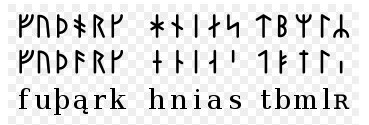2. In view of its importance for our efforts to translate the rongorongo signs I must here take the opportunity to list a sequence of 8 + 8 = 16 glyphs beginning with Ab6-42 (where its ordinal number 1116, counted from Aa1-1, possibly alludes to 11 * 16 = 2 * 88):
I suggest the 7 planets of the week are here describing 'the cycle of the turtle' (cfr the Mayan concept of a 'Middleworld' connected with the mystic number 7). Earlier, and before I discovered how the ordinal numbers in a glyph line can be used for indicating the planets (beginning with Mercury as number 1), I had constructed the following table:
I am still convinced this table is a correct interpretation of the meaning of the text. The ordinal numbers of the glyphs in the line is here not very relevant, because the greater pattern with 8 + 8 glyphs is much more prominent. Mars at Ab6-42 evidently determines where the rest of the planets will be located. Likewise Mercury is the beginning and end of the 2nd group. What can be added is that 16 very well here should also be regarded as 7 + 9, i.e. from vaha kai at Mercury (Ab6-49) Spring Sun (Mars) disappears into the Underworld (Xibalba, the Mayan Underworld, had 9 layers). And presumably 7 is 'the mystic number of the earth's surface' because there time should be counted in weeks. A third group with 8 glyphs probably illustrates the time when also autumn Sun has disappeared:
The 5 vai glyphs have all a single rim (meaning night), and their oval form has a little 'nipple' at bottom giving the appearance of a citrus fruit. Jupiter is at the beginning and end. At Mercury and Ab6-50 we should count 6 * 50 = 300 (Spring Sun has ended) and at Jupiter and Ab6-58 we should count 65 * 8 = 520, a number which could allude to 4 * 13 = 52 nights:
Our curiosity forces us one step ahead to look if we can identify the fishing grounds Taharoa and Rangi Meamea:
In Ab6-66 - which certainly is referring to the number of the Beast, 666 (= 111 * 6, cfr at Ab6-42) - tagata at left has not yet reached his point of standstill, he is looking ahead with open mouth (though not with a jaw of the spring type). His left arm is ending in a fist which becomes the top rhomb of an inoino sign, and possibly its meaning is to indicate the end of a season with 3 double-months counted from midsummer. His fist becomes the last of these double-months. Then darkness falls, cfr Saturn at Ab6-67, illustrated by how the 'arm of light', emerging from the bottom rhomb, is disappearing into a mea ke sign. Is it a coincidence that Metoro usually said mea ke at this type of glyph - where mea will make us think of Rangi Meamea? Double mea becomes its opposite, presumably, thus meamea is not the red of fish gills. I guess it is 'another kind of red', i.e. mea ke (where ke means 'another type of'):
Probably the 'fist rhomb' in inoino in front of tagata in Ab6-66 has become the bottom rhomb at left in Ab6-67, i.e. when passing the gap between the old and new year the inoino sign has been turned upside down, like an hour-glass. Moving ahead 3 * 8 = 24 glyphs from Mars in Ab6-42 we have reached Venus and Saturn at Ab6-66--67:
The enigma of number 8 (more mystic than 7) - exemplified by the change from 24 to 16 signs in the futhark alphabet - is above illuminated:
With 24 signs the planets (the 7 days of the week) will jump ahead 3 positions if we count to 8 for each group, e.g. from Mars to Jupiter. With 16 signs the jump ahead will be 2 positions. |
|||||||||||||||||||||||||||||||||||||||||||||||||||||||||||||||||||||||||||||||||||||||||||||||||||||||||||||||||||||||||||||||||||||||||||||









